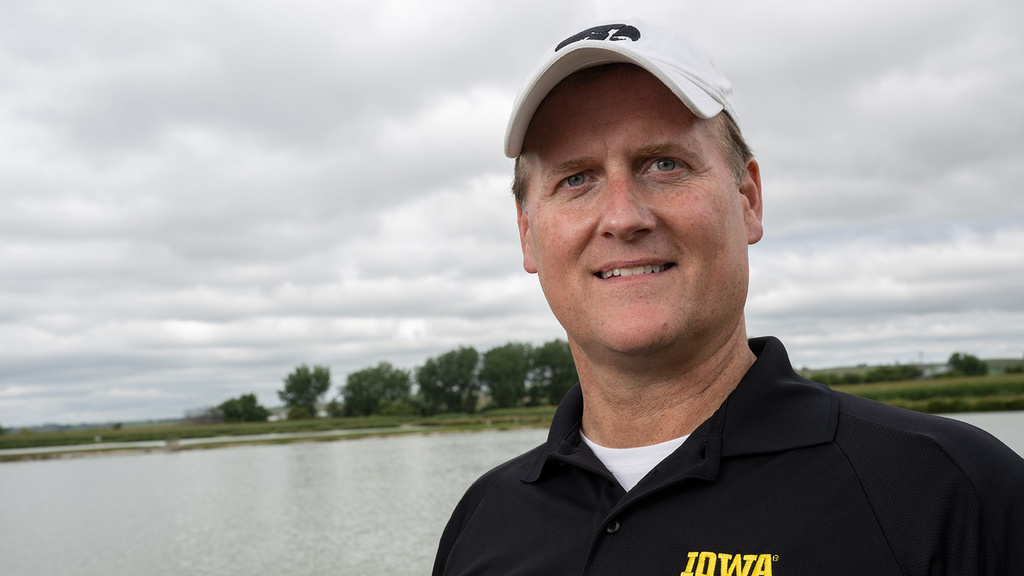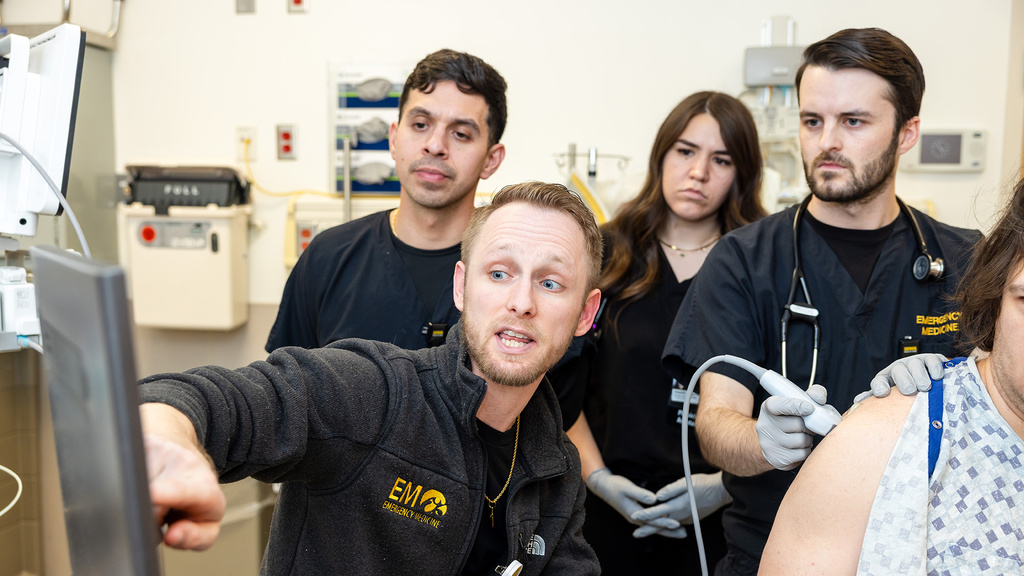Five years after the Iowa Flood Center at the University of Iowa helped the state win $97 million to address chronic flooding, the results are in: Under the guidance of regional watershed management bodies, 800 structures have been built across Iowa to reduce flooding and improve water quality.
Story: Richard C. Lewis
Photography: David Scrivner and IIHR—Hydroscience and Engineering at Iowa
Videography: David Scrivner
Published: Feb. 11, 2022
In 2016, with a nation reeling from years of natural disasters, the U.S. Department of Housing and Urban Development (HUD) made available $1 billion to help bolster the country’s extreme-weather defenses.
The money seemed preordained for big cities and coastal states. But leaders at the Iowa Flood Center (IFC) at the University of Iowa had an idea: Why not apply for funding that would address flooding regularly plaguing Iowa communities and address it at a watershed scale?
The IFC, working with partners statewide, won $97 million—the fourth highest total awarded—for a project called the Iowa Watershed Approach (IWA).
Five years later, regional groups centered around watersheds in Iowa have been organized. These watershed management coalitions, with support from IWA’s leadership, have overseen the building of 800 flood-reduction structures across the state, from Fremont County in far southwest Iowa to Winneshiek County in the state’s northeast corner. All told, the structures, ranging from simple ponds on farmland to elaborate, erosion-stabilizing projects on riverbanks, have reduced flooding from historic highs by as much as 20 percent in some areas. And they have cleaned the water, too.
“We’ve increased the understanding of people throughout Iowa about water,” says Larry Weber, co-founder of the Iowa Flood Center and the visionary behind the HUD funding application. “I think Iowans now better understand how floods happen, how they impact watersheds, and the effects on their communities. They better understand issues around water quality, too.”
Key to the Iowa Watershed Approach’s success has been Iowans themselves. Weber and others at the IFC knew regional and local support was essential. So, they hit the road, over and over, speaking with groups large and small to explain what the IWA is and how it could reduce flooding and improve water quality.

Iowa Flood Center
Thanks to the Iowa Legislature’s leadership and foresight in creating the Iowa Flood Center in 2009, Iowans have access to the latest technology and resources to help them prepare for floods and become more resilient to their effects. The center is actively engaged in flood-related projects that help Iowans understand their flood risks and make better flood-related decisions.
The first pitch was for folks to organize themselves around watersheds (an area of land that drains rainfall to a common outlet, such as a river). Water, after all, has no regard for town or county lines; it just goes where the terrain tells it to. What that means is rain falling in one area can greatly impact a landowner or community far away. So, the first step was to get multiple entities—cities, counties, soil and water conservation districts, and other stakeholders—to think about flooding as an issue that ranges far beyond their respective jurisdictions.
Iowans listened—and acted. Through the IWA and previously funded work, Iowa now has 27 watershed management authorities, addressing flooding and water quality for roughly 45 percent of the Hawkeye State.
Two of these watershed management authorities cover the East and West Nishnabotna rivers in southwest Iowa. The East and West Nishnabotna watershed is long and narrow, enveloping 1.1 million acres and multiple communities in 11 counties, from Carroll in the north to Hamburg hugging the Missouri River nearly 150 miles away. The area has been plagued by flooding, notably extreme rainfall events in 2011 and 2019. Those floods, along with the funding obtained by the IFC, motivated officials throughout the region to come together and tackle the problem as one.

A team at the Iowa Department of Natural Resources identified eight promising watershed regions when the $97 million in Iowa Watershed Approach funding came in. These regions include the West and East Nishnabotna and the North Raccoon in the western part of the state, and the Upper Iowa, Upper Wapsipinicon, Middle Cedar, Clear Creek, and English in the eastern part of the state.
“A lot of things are reactive. We react to the flood,” says Cara Morgan, project coordinator for the East and West Nishnabotna Watershed Management Coalition. “We go to the site of where that damage is rather than stopping the water where it needs to be stopped, where it falls. By putting together the watershed plan that we have with the East and West Nishnabotna, we’re able to address issues upstream where we can slow that flow to the southern communities and keep that peak flood down.
“We now have a watershed plan moving forward that we can use, and it is not going to sit on a shelf somewhere,” Morgan adds. “That plan will continue to be valuable. We wouldn’t have had that without the Iowa Watershed Approach.”
The IWA plan also required buy-in from individuals, namely landowners, upon whose properties the flood-reduction structures would be built. Thanks to the HUD funding, the IWA offered to cover as much as 90 percent of the costs.
Rick Mount jumped at that prospect. The third-generation family farmer in Riverton had been watching with mounting despair at a pond down the hill from his home that had become inundated with silt and infested with weeds due to flooding after heavy rains. When he learned of the IWA cost-share to build structures, he was eager to participate.
Now a bigger, deeper pond has been built on his land. It controls runoff, nets clearer water, attracts wildlife—and is a quiet spot for him to enjoy with his grandchildren.
“I guess there’s a little pride involved that I took care of this land,” says Mount, who has farmed for 44 years. “I’ve got a feature that’s nice to look at. And I think we’ve helped some communities downstream, too.”

Rick Mount, a third-generation family farmer in Riverton, had a pond down the hill from his home that had become inundated with silt and infested with weeds due to flooding after heavy rains. He was eager to participate in the Iowa Watershed Approach’s cost-share to build structures. Now a bigger, deeper pond has been built on his land. It controls runoff, nets clearer water, attracts wildlife—and is a quiet spot for him to enjoy with his grandchildren.

“I guess there’s a little pride involved that I took care of this land,” says Rick Mount, who has farmed for 44 years. “I’ve got a feature that’s nice to look at. And I think we’ve helped some communities downstream, too.”
Mount’s motivation has been echoed by landowners statewide who have participated in the IWA.
“We continue to have landowner interest and desire to accept these conservation practices on their land,” Weber says. “They see their neighbors’ building practices. They see the excitement around the program. And, while these practices certainly have a flood-damage benefit and a water-quality benefit, there are secondary benefits for each of these landowners. They can come out and enjoy the natural beauty of farm ponds and wetlands and reconnected floodplains. They really do appreciate that.”
For more than a decade, Allen Bonini had been leading a team at the Iowa Department of Natural Resources focused on watersheds and organizing coalitions around watershed management. It was slow, steady going: His team had identified eight promising watershed regions when the $97 million in IWA funding came in.
“The money empowered everyone to do things on a much bigger scale,” Bonini recalls. “For each of the watershed regions, they were able to hire a full-time staff person to work on that watershed project, whether it be continuing to build the coalition, to work with the hired consulting teams, to build a watershed plan, and to work with individual landowners on flood-reduction projects.”
“The Iowa Watershed Approach has two main objectives: Reducing flooding during heavy rainfall, and improving water quality year-round. A flood-first program plus improvement in water quality equals a more resilient Iowa.”
The watershed management authorities’ creation, and their successes, have been noticed: Iowa’s neighboring states all have inquired about the IWA. Delegations from Louisiana, North Carolina, and Texas visited the Iowa Flood Center to learn about how to organize flood-reduction practices on the watershed level in their states.
“They came with eyes wide open,” Weber says. “They’ve learned all that they can about the Iowa Watershed Approach. And we’re now seeing that those states are implementing programs of their own that emulate the Iowa Watershed Approach.”
With the federal funding nearing its end, Weber and others at the IFC are seeking ways to help the watershed management bodies across Iowa tap into new funding, so they may continue their work.
“The Iowa Watershed Approach has two main objectives: Reducing flooding during heavy rainfall, and improving water quality year-round,” Weber says. “A flood-first program plus improvement in water quality equals a more resilient Iowa.”



